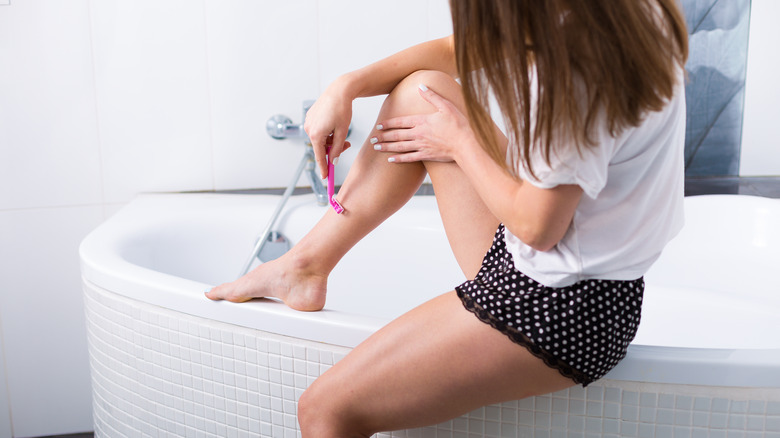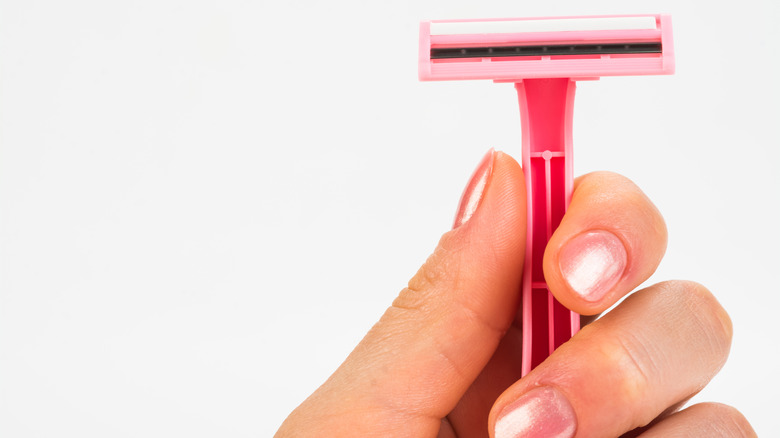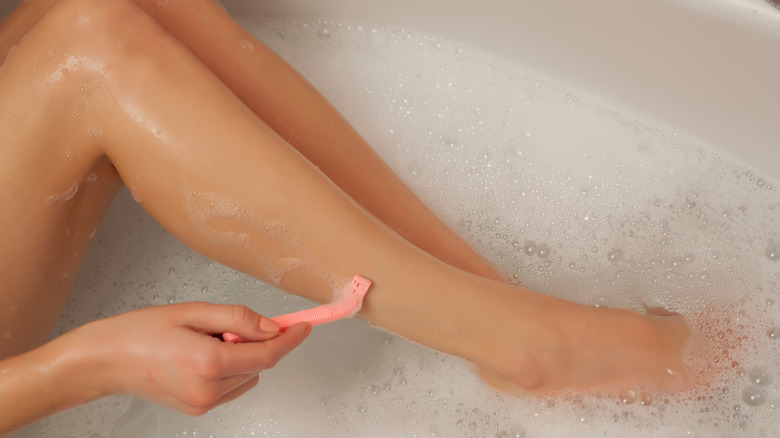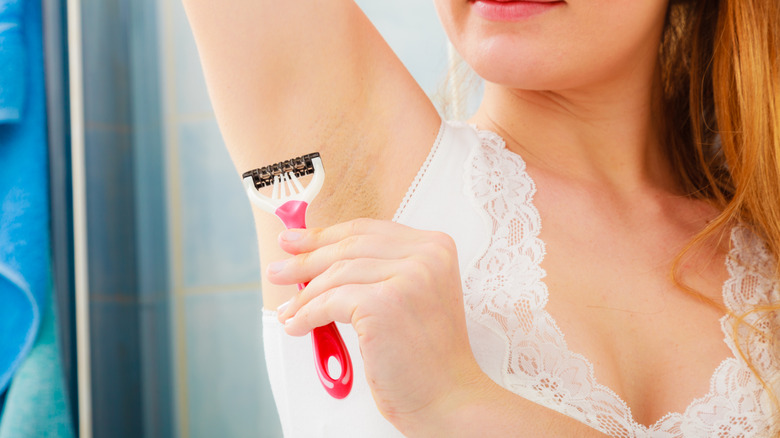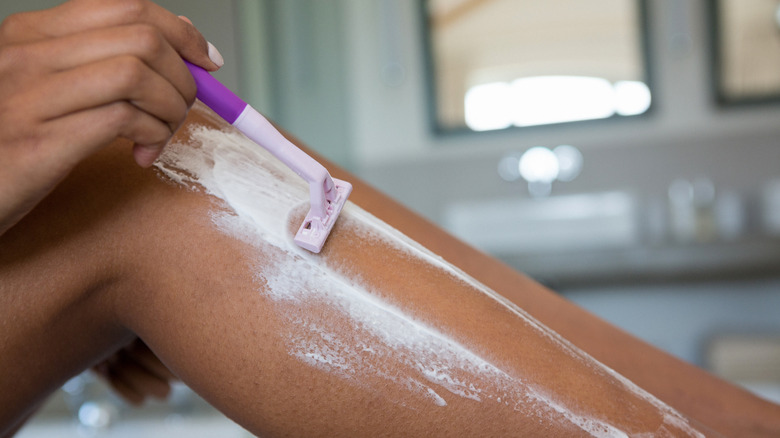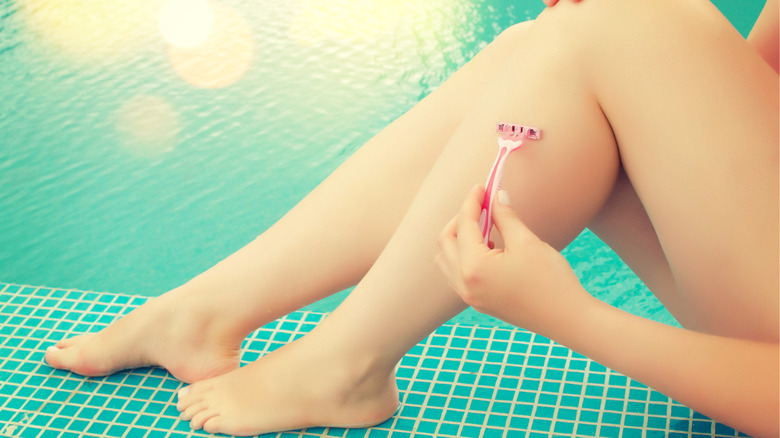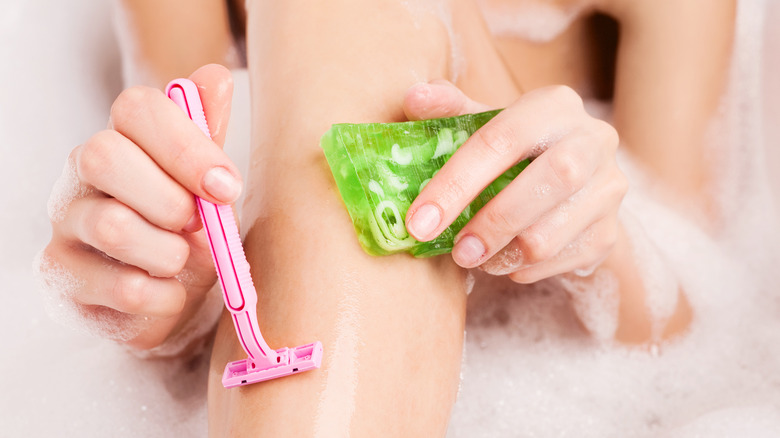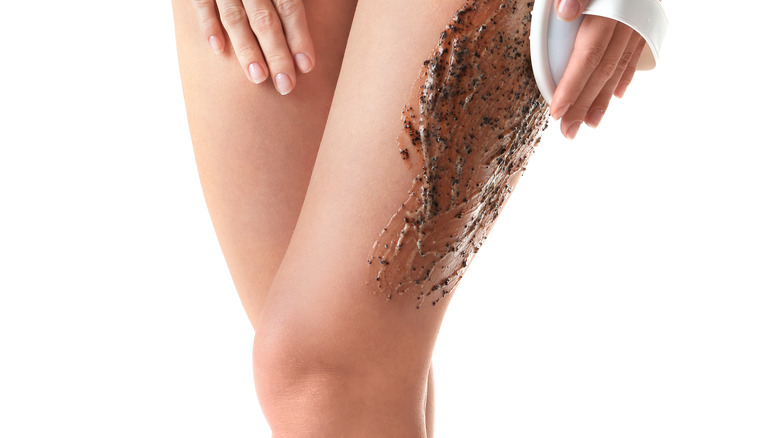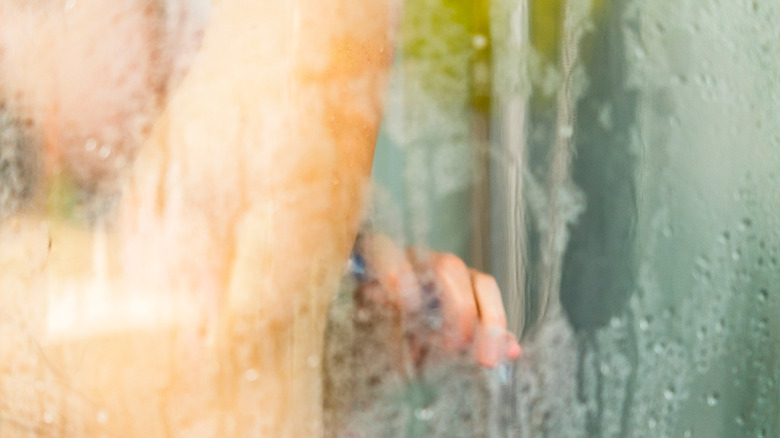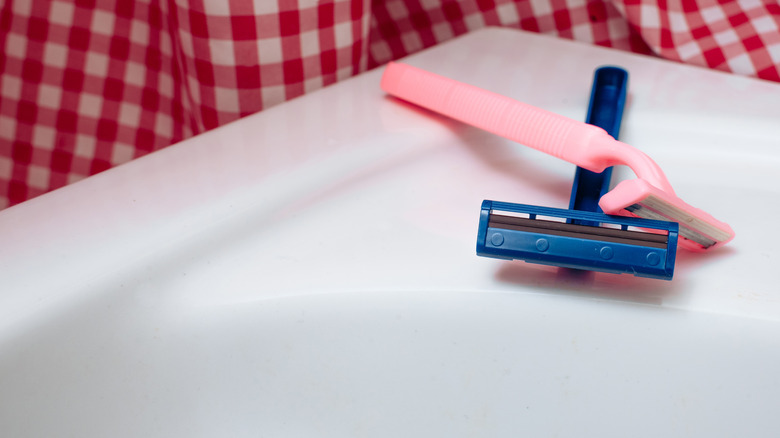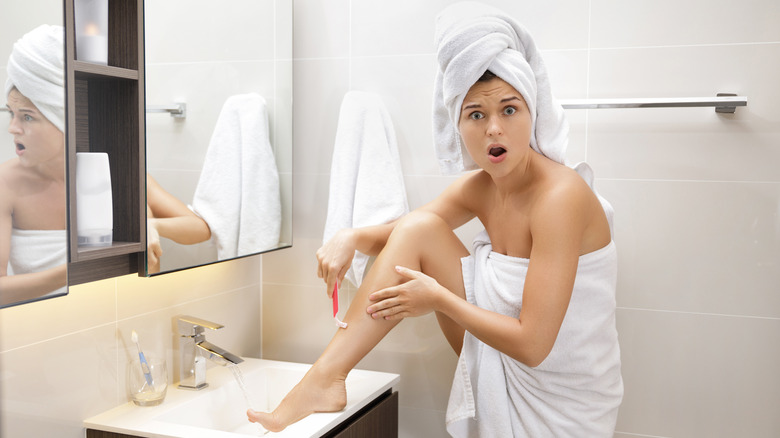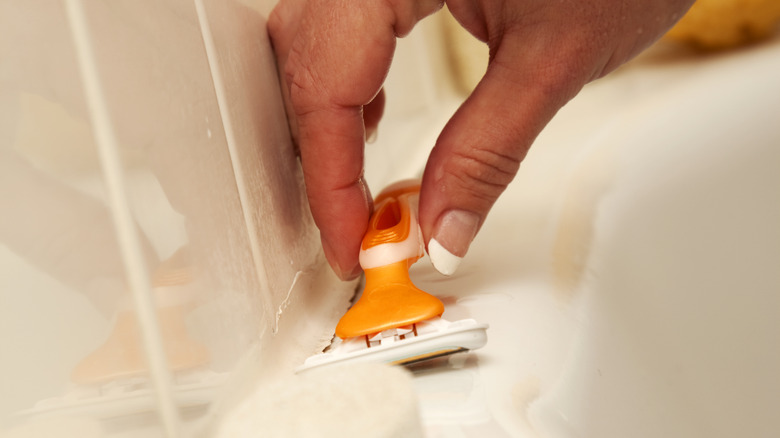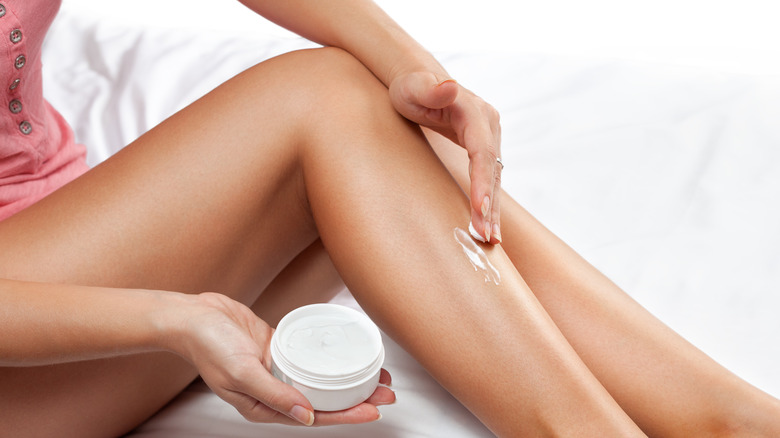Shaving Mistakes You Never Knew You Were Making
Shaving seems to be one of those necessary evils for many of us. Can you remember how old you were when you began the lifelong battle with your body hair? According to Parents, many girls start shaving around the time they enter puberty as this is when body hair becomes thicker. These days, that could be as young as 8 or 9 years old. Waiting until the tween years, however, is advised. Parents also suggests that good shaving techniques be taught prior to your child being given a razor. Makes sense.
Well, you've been shaving for what feels likes forever at this point, so you'd know exactly how to teach someone else to shave, right? As it turns out, we may be experienced when it comes to shaving, but we're far from pros. Whether you want to teach your child or learn the right way for yourself, we'd all benefit from knowing how to shave correctly. So, here are some of the absolute worst shaving mistakes we're all guilty of making and the reasons why we need to make some big changes in our shaving routines.
You're using the wrong kind of razor
Shaving is expensive. There's really no way around it. CBS Minnesota reported that it can cost between $20 to $30 to shave. The Gillette Fusion ProGlide Power razor, for example, works out to be about $1 each shave — and that's for a man. We ladies have the curse of shaving a greater surface area.
It may be tempting to pick up the cheapest multipack of razors you can find, but New York-based dermatologist Marnie Nussbaum doesn't think that's the best idea. "The razor does matter," she told Bustle. Single-bladed razors can't really compare to the close shave of two- or three-bladed razors. More blades than that, however, and you may run into problems.
"A razor with more than three blades cuts the hair too short," Christopher O'Connell, a cosmetic dermatologist based in Miami, explained. When hair is cut too short, it can cause those pesky — and often painful — ingrown hairs.
You shave in the tub
It may be easier and more comfortable to shave in the tub than in the shower, but, as with many things in life, the easy way often isn't the best way. Heather Wilson, an esthetician and director of brand development for InstaNatural skin care products, told Byrdie why the bathtub isn't quite right for shaving.
"Although a warm bath does soften the hair and make your shave feel more comfortable, the water also makes skin swell," she explained.
This means that when your skin is swollen, you won't be able to get as close of a shave as you would've otherwise. It may not seem like a big deal, but if a close shave is what you desire, then it really is. When you get out of the tub and the water-induced swelling subsides, you'll have legs full of stubble — not the bare, smooth skin you were probably expecting. Shaving in the shower is a much more efficient way to get a close shave.
You (sometimes) dry-shave
It's the first nice spring day. You're in a hurry so you don't have time to hop in the shower, but you just have to wear that super cute sundress you just bought. Your fur-lined legs insist a quick shave before brave the outside world. So, what do you do?
You may just be tempted to just grab your nearest razor and start hacking away at your leg hair, enduring the pain and dealing with the redness afterward. You may already have a hunch that dry-shaving isn't the best idea, but Joel Schlessinger, a board-certified dermatologist, tells us why this is.
"Shaving cream and gel were designed to help your razor glide gently across your skin without tugging or pulling," he said when speaking to Women's Health. When you dry-shave, he explained, you're "most certainly" left to deal with everything from razor burn to skin damage to cuts. It's not worth it, ladies!
You rush through shaving
Even if you're not one to attempt shaving dry, you may still rush through the shaving process. Shaving isn't exactly a fun experience and you've likely been doing it for years, so it makes sense to want to speed up the process.
A survey by the beauty product brand Ecestunal (via The Telegraph) discovered just how much time we're dedicating to getting rid of body hair: 72 days. That's right, 72 days of our lives are spent shaving our legs. The worst part? We probably need to be spending more.
"You're more likely to nick yourself, irritate your skin, or miss spots when you're trying to shave too quickly," Dendy Engelman, a dermatologist at Manhattan Dermatology and Cosmetic Surgery in New York City, told Women's Health UK. Instead of rushing, he advised working carefully and using "smooth, even strokes" as a way to prevent both cuts and irritation.
You often forget to wash up before shaving
If you're going to lather up your legs with shaving cream anyway, do you really need to wash your limbs with soap first? It may sound somewhat like an unnecessary step, but when you really think about it, it makes a whole lot of sense. You're literally going to push a sharp blade against your skin and if that skin is dirty (aka full of bacteria)? Ew! Pretty gross, wouldn't you say?
Dermatologist Melissa Kanchanapoomi Levin, a clinical instructor at Mount Sinai Icahn School of Medicine, says your shaving routine should begin with soap and water. This is essentially how you get your skin ready for a close shave. "Wetting the skin and hair with warm water and gentle soap softens the hair and skin," she told Cosmopolitan.
So, it all boils down to this: If you want smooth clean legs, you really can't afford to skip scrubbing up.
You shave in the wrong direction
The American Academy of Dermatology lists shaving in the direction your hair grows as a vital step in preventing razor burn and bumps. This means you should be shaving down the leg as opposed to up. If that's the case, why do so many women shave in the opposite, and not recommended, direction? Likely for a closer shave.
Neal Schultz, a cosmetic dermatologist, told Good Housekeeping that shaving "against the grain" may indeed get you a closer shave, but it also ups your chances of cutting yourself and irritating your skin. Here's what to do if you still want that close shave: Shave down your leg first. Then, follow Schultz's advice to "reapply the gel and shave again — against the direction of the hair growth." This is the safest way to get a close, "wrong" direction shave. Those with very sensitive skin, however, should never shave up (against the direction of hair growth).
You use soap when you run out of shaving cream
It can be tempting to reach for the bar of soap when you've realized you've run out of shaving cream, but that doesn't mean it's a good idea. As it turns out, soap is far from being a viable replacement for the lathering shaving foam or gel we should be using.
"It doesn't create enough lubrication for a razor to slide easily against your skin, which can up the odds of cuts," Dermatologist Ellen Gendler explained to Good Housekeeping.
"When you think about it, men would never shave without a shave prep, and that's for a reason," New York City dermatologist and clinical instructor at Mount Sinai Icahn School of Medicine Melissa Kanchanapoomi Levin explained to Cosmopolitan. That's certainly true. We should take a lesson from the dudes in this situation and stick to solely using shaving cream. After all, it is its intended purpose.
You can admit it, you don't exfoliate before shaving
Do you know anyone who exfoliates as much as they should? According to the dermatologists who spoke with Health, most women should be exfoliating twice a week. If you have oily skin, you can even get away with exfoliating more often than twice a week. If you're someone who often neglects exfoliating, you should try to at least exfoliate before you shave.
"Women tend to forget that exfoliating the legs prior to razor use will remove the dead skin cells, allowing easier gliding and better hair removal," Dr. Nussbaum told Bustle.
Not only does exfoliating make for an easier time shaving, it can also "dramatically decrease" ingrown hairs and even razor bumps, according to Dr. Nussbaum. And, let's be honest, razor bumps suck and ingrown hairs are downright awful. If there's a way to prevent them, or at least have fewer occurrences, it's definitely worth giving it a shot.
You use your disposable razor for way, way too long
Disposable razors are often the cheapest you can buy and you really get your money's worth if you use them for as long as possible, right? Maybe, but the damage you're doing negates the pennies saved.
"Dull blades are more likely to cause razor bumps, irritation, nicks, and cuts," Dr. Schlessinger explained to Women's Health. As if that weren't bad enough, Dr. Schlessinger also said old blades can be home to bacteria. And with bacteria, it may not be long before infection starts to follow.
"A good rule of thumb is if you feel like it's tugging at your hair or skin, toss it — it's most definitely a ticking time bomb waiting to irritate," Dr. Engelman added. Even if you feel like your disposable razor could hang in a little longer, you should probably aim to toss it after a week. Yes, a week. Any more than that and you're really flirting with disaster.
You borrow your partner's razor from time to time — eek!
What do you do when you lather up your legs, all ready to shave, only to realize you've forgotten your razor? Your eyes may instantly hone in on your partner's blade. While you may think it's easier just to use theirs, don't do it! Yes, you should actually get out of the shower and hunt down your own. That, or skip shaving, of course.
You may love your partner, but do you love them enough to share fungal infections? In this case, sharing is not caring. Dermatologist Whitney Bowe explained to InStyle, saying, "Shaving results in tiny nicks in the skin and those openings can allow bacteria to enter and spread infection." Bowe said this means you're making yourself "vulnerable to warts" as well as "bacterial and fungal infections." What's worse, if there happens to be blood on the razor, transmitting blood viruses is all too possible.
Even if you spy your husband's never-been-used razor sitting in the shower, you probably shouldn't reach for it. "Women's razors are designed to help shave large surface areas whereas men's razors are made for shaving their face," Bowe explained. Yes, to each his own ... razor.
You shave too hard
It may almost be instinct for you to want to apply a lot of pressure when shaving. You may feel that pushing hard equates to a closer shave. It doesn't.
Dr. Engelman explained the nitty-gritty behind shaving pressure to Women's Health, saying, "The harder you bear down, the more uneven the skin surface becomes, because you are essentially creating dimples where the blade falls."
If you aren't getting a close shave without applying a significant amount of pressure, you may want to examine the blades of the razor you're using. "It's the same thing as knives," New York-based dermatologist Amy Wechsler explained to Teen Vogue. "People think you're more likely to get hurt with a sharp knife, but a dull knife is actually more dangerous to use because you have to push harder to get it to work." Why do all the extra work with none of the benefits? New sharp razors are your friends.
You leave your razor on the ledge of the tub
The flat ledges of a tub may seem like the best place to keep your razor. After all, you'll never have to hop out of the shower while soaking wet to track it down. Nevertheless, it's still a pretty terrible idea to keep your razor in that location.
While most razor blades are made of stainless steel, which is impervious to rust, water and razors still don't mix all that well. Keeping your razor on the ledge of your tub means it will get drenched in water with every shower you, or anyone else in your household, take.
"The water exposure can make it dull faster, and it's just not clean," Dr. Levin put it bluntly when speaking with Cosmopolitan. "You're bathing your razor in a pool of water that just sits there." Okay, okay, it's time for all of us to find new homes for our razors.
You don't moisturize after shaving
What you do after shaving is arguably as important as what you do before and during. "Dry skin can become irritated more easily than moisturized skin," Esthetician Heather Wilson told Byrdie. Wilson further explained that irritated skin becomes more prone to problems like redness and ingrown hairs. Skipping the moisturizer after shaving is quite a bad idea. Instead, Wilson recommends applying either a lightweight lotion or body oil.
While Wilson favors rosehip seed oil for post-shaving application, you could also opt for coconut oil. Vermén Verallo-Rowell, a dermatologist and founder of the skincare line VMV Hypoallergenics, explained to Byrdie that it contains "anti-inflammatory and antioxidant benefits to repair and soothe the skin."
Whichever type of oil or lotion you determine to be best for you, the most important thing is that you remember to use it. Shaving puts our skin through a lot so, doesn't it deserve some lovin'?
